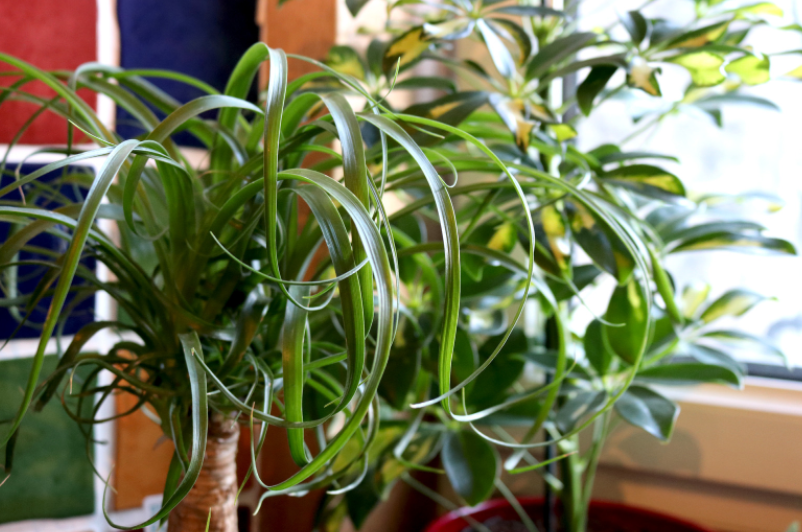
Fascinating Ponytail Palm
The plant is beaucarnia guatemalensis, commonly referred to as ponytail palm. A short-leafed beaucarnia is much more compact than its counterpart b. recurvata has long trailing leaves that can grow to 5 feet or longer.
In this picture, B. guatemalensis is a multi-headed chopped stem that is rooted out and planted in a short, small dish to allow for a small root system.
If you purchase one of these, I recommend removing it from its plastic pot immediately. It is a dry plant and cannot stand to be too wet. Substitute clay for the plastic container and use unglazed red pottery. Your plant will thank you.
The ponytail palm is no palm, but since it has a long trunk and a mop at the top, it looks like a palm and will grow slowly towards that end.
It is a very slow progressing plant that does not require intense light, making for a good solid addition to the collection of arid-type plants.
How To Care For Ponytail Palm
Water once every two to three weeks in summer and every month in winter.
These remarkable plants can stay in the same containers for years and adapt well to drought conditions. Desert dwellers can be a compliment or a feature in the garden.
Tropical plants will not withstand frost.
So please take care to remove them from the outdoors as autumn approaches. Keep them protected from exposure to the sun, or they will sustain severe sunburn.
This new ponytail form hails from South America and is becoming increasingly popular. Eventually, the base of the plant will develop a thick trunk, and the heads will grow into long branches with the tips spouting deep green leaves as in the picture.
This new form is in limited supply, but watch for it to become one of the plant lover’s favorites. No pests, save the dreaded mealybug and a few odd scales, this plant is no headache to care for.
Simply put, it offers slow patient growth with a minimum of sacrifice on your part. The look of this plant is so appealing, and it looks so much like a bad hair day. It provokes a smile to my face every time I look at it.
It is not really a palm, but to early discoverers in its native Mexico, it looked the part. Outdoors in ideal conditions, it grows into a large plant maybe five meters tall, but as an indoor plant in a pot, it is far more petite, generally small enough for a windowsill or ledge.
It is not toxic to animals. It bears fruit, but seldom with indoor specimens.
It is a tropical plant with great structure and loads of character. It’s low maintenance and has a great ability to store water in its trunk.
Watering
The ponytail palm takes its name from its resemblance to hair cascading out of a ponytail. It’s also called a “bottle palm” because its trunk becomes a bottle-like bulb at soil level.
Ponytails are native to the dry Mexican climate. This habitat allows it to survive interior winter heat very well, as long as the plant doesn’t receive too frequent waterings.
Due to their enormous size, the majority of the plants are rootbound. Even though they can store water in their bulb and utilize it slowly, there is likely not much soil in their pot.
If the plant’s roots become overly dry, the lower leaves become brown or yellow and the plant takes on an ashy appearance.
You need proper drainage and appropriate lighting. And whether you keep it inside the house or outside, it doesn’t like full-sun exposure – a common misconception about tropicals.
It likes a lot of natural daylight.
The palm can grow up to 5-ft. tall and the “ponytail” gets a little bushy, but the result is stunning.


























